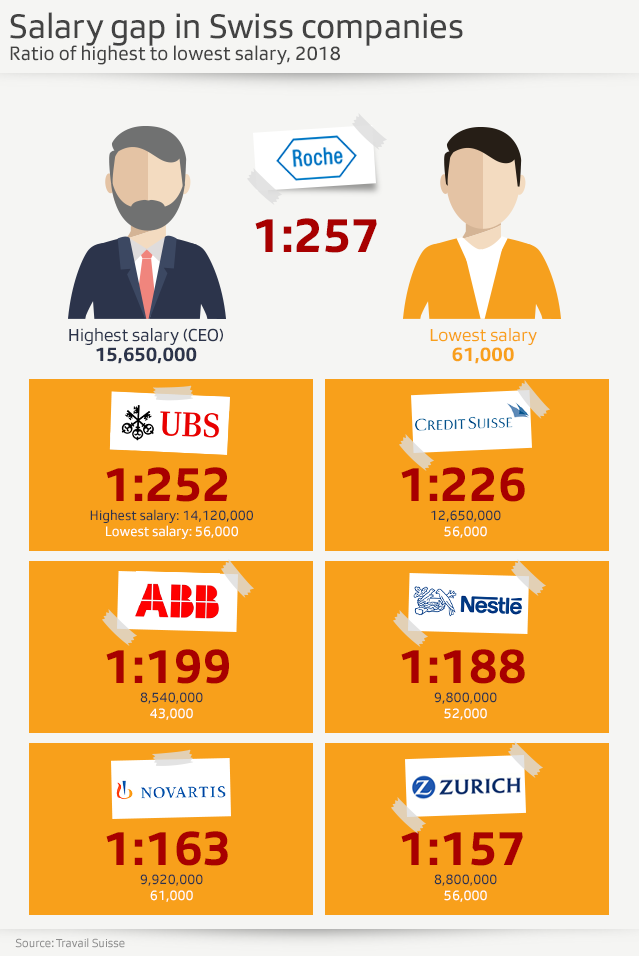Women’s strike should be a wake-up call for Swiss companies
Swiss women protested en masse on June 14 calling for equal treatment in the workplace and beyond. Allyson Zimmermann argues that a fairer workforce is good for business and shares what companies can do to help close the gender gap. As the Europe Executive Director of Catalyst, she provides guidance on creating workplaces that work for women.
Swiss women confront many barriers in the workplace. Challenges include a school system generally not designed for working families and a high part-time working culture, forcing many women on to the “mummy track”.
They are not alone. When Catalyst’s global research looked at the traits of a so-called ‘ideal workerExternal link’, we found that even when women did “all the right things” to advance, it did not have the same pay off as it did for men.
We also found that men are promoted based on potentialExternal link whereas women are often promoted based on proven performance. This means women tend to make more money by staying with the same employer than by switching jobs, while the opposite is true for men.
Similarly, the pay gapExternal link has nothing to do with women’s career choices or with having children. Instead the barriers in the system which are holding women back include a lack of women role modelsExternal link, not getting high-profile assignmentsExternal link, not having powerful sponsorsExternal link and exclusion from informal networksExternal link. For instance, it’s not always possible or desirable for women to join in with the after-work drinking culture of an organisation.
A gap from the get-go
From day oneExternal link, we found that women are paid less and start at a lower level than their male counterparts, despite being similarly qualified and sharing the same career aspirations; and this gap only widens over time. And while many attempt to explain this by women not negotiating, research shows the opposite. Women doExternal link negotiate, and almost as often as men but this may not be enough to close the gap for women. Catalyst found 47 percent of women vs. 52 percent of men negotiated for a higher salary during the hiring process for their current position.
The workplace of the future must embrace diversity and inclusion. Diverse teams and inclusive culturesExternal link, that leverage their multitude of strengths, backgrounds, and perspectives, makes companies more competitive. It increases innovation and productivity, leads to better performance and problem solving, reduces groupthink, and enhances decision-making.
The culture of an organisation comes from the very top and senior leaders’ need to model the right behaviours and support cultural change to create inclusive workplaces.

How to close the gender gap
Practical actions to support women include championing flexible work policiesExternal link, getting involved with company-specific gender equality initiatives, and sponsoring a high-potential womanExternal link (because sponsors, unlike mentors, will advocate for protégés behind closed doors).
Similarly, closing the pay gap starts with organisations taking action, from conducting a wage audit to establish the size of their gender pay gap, to implementing a “no negotiations” policy. Studies show when women negotiate for higher salaries,External link people react more negatively than they would towards a man asking for more money.
Transparency around pay is also essential to stop the culture of secrecy that often surrounds salaries. Salaries or salary bands should be published, along with explanations and discussions, to ensure clear and open lines of communications. In NorwayExternal link, which is ranked third out of 144 countries in terms of wage equality for similar work by the World Economic Forum, workers are able to see online what a colleague earns, as well as their tax obligations and assets.
Finally, Catalyst recommends that organisations take a hard look at their recruitment, promotion, and talent development systemsExternal link to see where and if any gender biases creep in.
The recent announcement by the Swiss parliament requiring companies to have 30% women board directors within five years, and 20% on executive boards within ten years, is also a step in the right direction for gender equality on boards.
Fix the workplace
While these targets are not legally-binding, what we see around the world is that without a focused intent on prioritising gender diversity on corporate boards, change does not simply happen.
We need to appoint and promote more women, including ethnically and racially diverse women to boards, executive teams, and at every level of the company with metrics baked into the business and managed like any other success driver.
For too long, there’s been a focus on fixing the women’. Instead, we need to address the systemic barriers that are holding women back, and “fix” the workplace.
Organisations need to challenge the decisions made about talent and who gets what projects; the status quo of how things have been done; and to ask better questions to ensure that talent is not being sacrificed to the assumptions made about “talent”.
To compete effectively in the global marketplace requires leaders and teams from all genders, cultures, backgrounds, and experiences. Inclusive, diverse leaders can propel this transition by creating innovative, dynamic workplaces where employees feel connected to and supportive of one another, and where everyone can advance and thrive. A more equitable workforce is good for women and for society as a whole.
The views expressed in this article are solely those of the author, and do not necessarily reflect the views of swissinfo.ch.
Opinion series
swissinfo.ch publishes op-ed articles by contributors writing on a wide range of topics – Swiss issues or those that impact Switzerland. The selection of articles presents a diversity of opinions designed to enrich the debate on the issues discussed.


In compliance with the JTI standards
More: SWI swissinfo.ch certified by the Journalism Trust Initiative


You can find an overview of ongoing debates with our journalists here. Please join us!
If you want to start a conversation about a topic raised in this article or want to report factual errors, email us at english@swissinfo.ch.